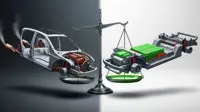Study provides new evidence of cooling properties of atmospheric molecule
24 Apr 2013
Scientists have discovered further evidence for the existence of new molecules in the atmosphere that have the potential to off-set global warming by reacting with airborne pollutants.
Researchers from The University of Manchester, Bristol University, Southampton University and Sandia National Laboratories in California have detected the second simplest Criegee intermediate molecule – acetaldehyde oxide – and measured its reactivity.
Intermediates are molecules that are formed during a chemical reaction and react further to produce the final chemicals of the reaction. Criegee intermediates – carbonyl oxides – were first identifies by the team in January last year and shown to be powerful oxidisers, reacting with pollutants such as nitrogen dioxide and sulphur dioxide.
The authors, whose latest study is again published in the journal Science, believe Criegee intermediates have the potential to cool the planet by converting these pollutants into sulphate and nitrate compounds that will lead to aerosol and cloud formation.
Professor Carl Percival, who led the Manchester team in the University's School of Earth, Atmospheric and Environmental Sciences, says, ''We have carried out the first ever studies on the second simplest Criegee intermediate and were able to show that it also reacts extremely quickly with sulphur dioxide to produce sulphates under experimental conditions.
''We can therefore say that the reaction of these intermediates with sulphur dioxide will have a significant impact on sulphuric acid production in the atmosphere if they follow the pattern established by these two studies.
He continues, ''One of the main questions from our first study was if this increased reactivity would be observed for other Criegee intermediates, so with these findings we now have additional evidence that Criegee intermediates are indeed powerful oxidisers of pollutants such as nitrogen dioxide and sulphur dioxide.
''What this study suggests is that the biosphere could have a significant impact on aerosol production and thus potentially climate cooling via the formation of Criegee intermediates. The next steps will be to carry out modelling studies to quantify the impact of Criegee intermediates on climate and to quantify the level of alkene present in various environments.''
The formation of Criegee intermediates or biradicals was first postulated by the German chemist Rudolf Criegee in the 1950s but, despite their importance, it had not been possible to study the chemicals in the laboratory.
The detection of the molecules was made possible through a unique apparatus that uses light from a third-generation synchrotron facility at the Lawrence Berkeley National Laboratory.
The latest study has also revealed which of the two isomers of acetaldehyde oxide is the most reactive. Isomers are molecules that contain the same atoms but arranged in different combinations, while conformational isomerism refers to the way the atoms of a molecule are rotated around a single chemical bond.
''In this new paper we have been able to show that the reactivity depends on the conformer of acetaldehyde oxide in a dramatic way,'' said Professor Percival. ''The 'anti' conformer is much more reactive than the 'syn' conformer, which we believe more likely to be formed in the atmosphere. This enabled us to measure the rate coefficient for reaction with water for the first time; the removal, via reaction with water, is of vital importance if we want to understand the role of Criegee intermediates in the atmosphere.''
Sandia combustion chemist Craig Taatjes, the lead author on the paper, added: ''Observing conformer-dependent reactivity represents the first direct experimental test of theoretical predictions. The work will be of tremendous importance in validating the theoretical methods that are needed to accurately predict the kinetics for reactions of Criegee intermediates that still cannot be measured directly.''

.webp)




















